
The ornate chorus frog is a species of chorus frog endemic to the Southeastern United States. Their distribution ranges from North Carolina, east to the very eastern part of Louisiana, and south to northern parts of Florida.
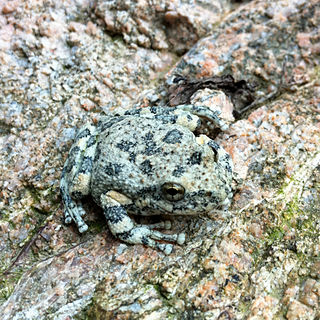
The California tree frog or California chorus frog is a "true" tree frog from southern California (USA) and Baja California (Mexico). Until recently, the California tree frog was classified in the genus Hyla.
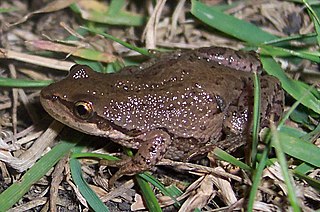
The boreal chorus frog is a species of chorus frog native to Canada from central Quebec to eastern British Columbia and north to the Northwest Territories and the southern portion of the Yukon. It occurs in the USA throughout Montana, northwestern Wisconsin, northeastern Arizona, northern New Mexico, and southwestern Utah.

The spotted chorus frog or Clark's tree frog is a small, nocturnal tree frog native to the grasslands and prairies of the central United States and Tamaulipas, Mexico. It is found from central Kansas, Oklahoma, and northeastern New Mexico to the Gulf of Mexico and Rio Grande valley in Texas and Tamaulipas.
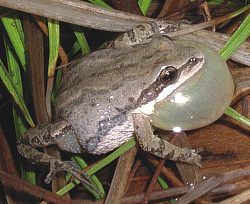
The western chorus frog, also known as striped chorus frog, or midland chorus frog is a species of frog found in Canada and the United States.
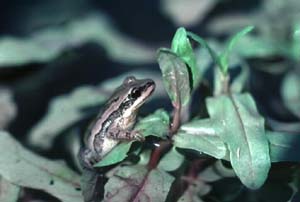
The upland chorus frog is a species of chorus frog found in the United States. It was recently separated from the Western chorus frog,, being identified as an individual species rather than a subspecies.

The little grass frog is a species of chorus frog endemic to the Southeastern United States. It is currently the smallest North American anuran and occurs in a wide variety of ephemeral and semi-permanent wetlands.

The pig frog is a species of aquatic frog found in the Southeastern United States, from South Carolina to Texas. Some sources also refer to it as the lagoon frog or the southern bullfrog.

Ficimia streckeri, also commonly known as the Mexican hooknose snake, the Tamaulipan hooknose snake, and the Texas hook-nosed snake, is a small species of snake in the family Colubridae. The species is native to northeastern Mexico and adjacent southern Texas.
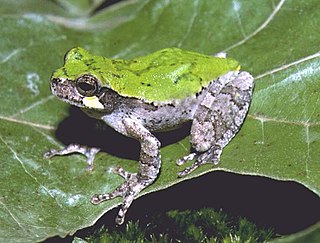
The bird-voiced tree frog is a species of frog in the family Hylidae, endemic to the United States. Its natural habitats are temperate forests, shrub-dominated wetlands, and swamps.

Dryophytes eximius, commonly known as the mountain tree frog, is a species of frog in the family Hylidae endemic to Mexico. Its natural habitats are mesquite grasslands, scrub forests, and pine-oak forests. It is a widely distributed species that faces no major threats.

The Appalachianmountain chorus frog, formerly known as just the mountain chorus frog, is a species of frog in the family Hylidae. The species is endemic to the United States. The natural habitats of P. brachyphona are temperate forests, rivers, intermittent rivers, swamps, freshwater marshes, intermittent freshwater marshes, freshwater springs, ponds, open excavations, and canals and ditches. It is threatened by habitat loss.
Brimley's chorus frog is a species of frog in the family Hylidae, endemic to the United States, and is named for North Carolina zoologist C.S. Brimley. Its natural habitats are subtropical forests, rivers, intermittent rivers, swamps, freshwater marshes, intermittent freshwater marshes, ponds, open excavations, and canals and ditches. It is threatened by habitat loss.
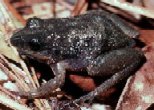
The southern chorus frog is a species of frog in the family Hylidae, endemic to the southeastern United States. Its natural habitats are temperate forests, temperate grassland, shrub-dominated wetlands, swamps, freshwater marshes, intermittent freshwater marshes, ponds, open excavations, seasonally flooded agricultural land, and canals and ditches. It is threatened by habitat loss.
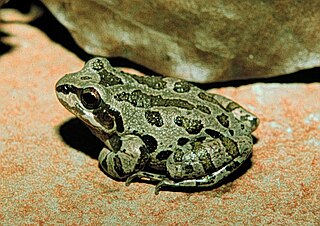
The Illinois chorus frog is a species of chorus frog that lives in scattered, restricted habitat ecosystems in the states of Arkansas, Illinois, and Missouri. It was published by Smith in 1951. Its life cycle is little known, its isolated populations are increasingly restricted by agricultural drainage, and it is listed as a threatened subspecies. It is often referred to as a subspecies of P. streckeri. Collins recognized it as its own species which was followed by ASW6.0 and Amphibiaweb on the basis of its diagnosability from Pseudacris streckeri and its allopatry. The IUCNredlist 2013.2 has not incorporated this taxonomic split.
Pseudacris kalmi, the New Jersey chorus frog, is a species of frog in the treefrog family Hylidae. It is found in the states near New Jersey in the United States. It was first described as subspecies of Pseudacris triseriata but it is differentiated by range and size. This frog's color ranges from grey to tan or greenish brown with a dark stripe on both sides of the body that extends from the snout, through their eyes, and to the groin. It breeds in early spring from February to April. It broods in shallow bodies of water, especially vernal pools, which dry up later in the season.
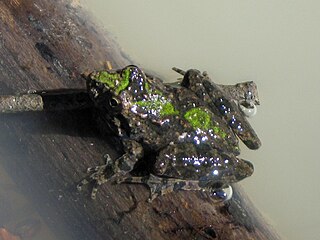
Acrisinae is a subfamily of the tree frog family Hylidae. There are only two genera in this subfamily, Acris and Pseudacris. They are native to most of the Nearctic realm, and are found as far north as the Great Slave Lake in Canada, all across the United States, and down Baja California and some parts of northern Mexico. One species, the pacific tree frog, has been introduced to several locations outside its range, and it is possible that other species may have been as well.
















